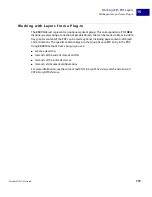
Acrobat SDK User’s Guide
103
Working with Metadata
The Adobe XMP Toolkit
12
Accessing XMP Metadata Using Acrobat JavaScript
The
metadata
method of the Acrobat JavaScript
doc
object allows you to access the XMP
metadata embedded in a PDF document. The method returns a string containing the XML
text stored as metadata in a particular PDF document.
Accessing XMP Metadata From a Plug-in
You can access XMP metadata information using the Acrobat SDK. Plug-ins can get or set
XMP metadata using the
PDDocGetXAPMetadataProperty
and
PDDocSetXAPMetadataProperty
APIs. Using these APIs, you can access all of the
properties in a
pdDoc
's
Info
dictionary, as well as properties that are not in the
Info
dictionary.
N
O T E
:
The term “XAP” refers to an early internal code name for Adobe’s Extensible
Metadata Platform (XMP). For more information on this protocol, see the
Adobe XMP
Specification
.
You can also get or set the XMP metadata associated with a Cos dictionary or stream, or
with a PDEContainer. These APIs are all included in the
PDMetaDataCalls.h
header file.
See the
Acrobat API and PDF Library API Reference
for more information on these APIs.
Acrobat Distiller and XMP Metadata
Acrobat Distiller supports embedding of XMP metadata in PDF files in two ways.
First, it always generates document level metadata. This metadata is derived from the
PostScript file and cannot be modified by the PostScript program. To change the document
level metadata, you must change it in the authoring application that generates the
PostScript stream.
A second way of adding metadata is to create object data. See
“Object Data” on page 104
for more information.
The Adobe XMP Toolkit
The XMP Toolkit is designed to help applications handle XMP operations such as the
creation and manipulation of metadata. The Toolkit makes it easier for developers to
support XMP metadata, and helps to standardize how the data is represented and
interchanged. The XMP Toolkit can be licensed, royalty-free, from Adobe Systems.
The XMP Toolkit features a C++ interface which uses some modern (ANSI) features, such as
exceptions
,
STL strings
, and
bool.
It uses conservative coding and interface design for
maximum portability and to make it easier for developers to adopt.
Summary of Contents for Acrobat 7.0.5
Page 10: ...Contents 10 Acrobat SDK User s Guide ...
Page 66: ...Modifying the User Interface Customizing Acrobat Help 6 66 Acrobat SDK User s Guide ...
Page 78: ...XML and the Acrobat SDK Managing XML based Information 8 78 Acrobat SDK User s Guide ...
Page 100: ...Providing Document Security Document Rights 11 100 Acrobat SDK User s Guide ...
Page 106: ...Working with Metadata Object Data 12 106 Acrobat SDK User s Guide ...
Page 110: ...Searching and Indexing Indexing PDF Documents 13 110 Acrobat SDK User s Guide ...
Page 118: ...Working With PDF Layers Working with Layers from a Plug in 15 118 Acrobat SDK User s Guide ...
















































